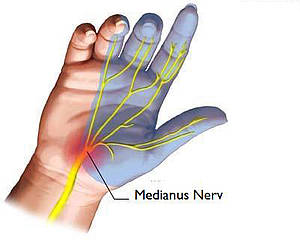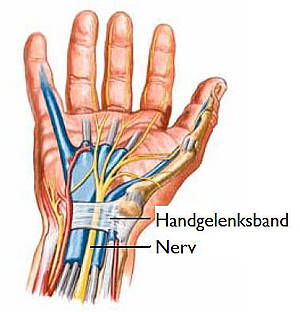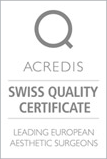Nerve constriction (Carpal tunnel syndrome)
The cause of the so-called carpal tunnel syndrome is a constriction of a major nerve in the narrow passage of the wrist. The nerve, accompanied by the finger flexor tendons, passes through a narrow canal, bordered on 3 sides by wrist bones and on top by a tight transverse carpal ligament. Causes for a spatial imbalance in this carpal tunnel may be poorly healed fractures, a thickening of the wrist band, swelling or growths. However, in most cases, there is no pathological change, and the carpal tunnel syndrome is said to be of unknown cause. Women are frequently affected, and often on both sides.
Typical indications of carpal tunnel syndrome are nocturnal formications (“pins and needles”) in the affected hand. The patient is awakened by a tingling or prickling pain in the early morning hours—often in the thumbs, index finger, middle finger and half of the ring finger.
It is also described by complaints of clumsiness in buttoning and unbuttoning, sewing or picking up small objects. In later stages, complaints of decline in gross motor function are typical, and this is visible as a regression of the muscle tissue of the thumb joint.
The diagnosis is confirmed by a measurement of nerve conduction speed. The recommend conservative measure of immobilization with wrist support rarely has a long-lasting success even in less severe cases with minimal pain. Cortisone injections are strongly discouraged, as these can actually increase the pain over the long term.
If a carpal tunnel syndrome does not improve after 3 months of wearing a wrist support and the patient is still suffering from the pain, an operation is advisable. We perform the procedure on an outpatient basis and with regional anesthetic. The transverse carpal ligament is split lengthwise by making an approximately 3 cm long, L-shaped incision within the skin fold lines. This gives the flattened and compressed nerves in this area space to recover.
In the first few days after an operation, you should protect the affected hand and keep it elevated (arm sling). The fingers should be moved regularly without load, and after a few a days, light activity can resume. The stitches are removed after around 10-14 days, and more intensive activity is possible again after 2-4 weeks. For extreme stresses (e.g. heavy construction work), a recovery time of 4-6 weeks is to be expected. The longer the pain and constriction of the nerves lasted before, the longer the time for a complete recovery of the nerves.



